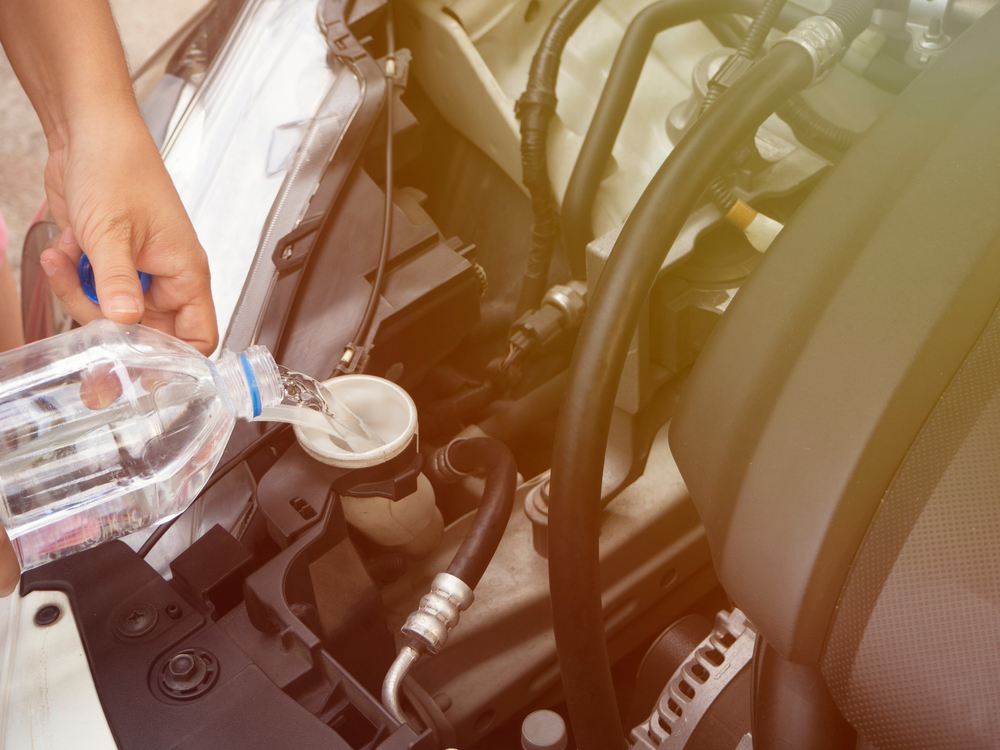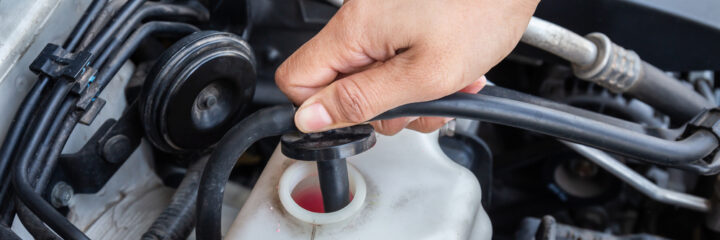You are driving down the road when, oh no, the temperature gauge climbs into the red. The lights light up, the car beeps, and a sense of panic creeps in. You pull over to the side of the road just in time for coolant to start dripping out of the front end. Worse-case scenarios start playing through your head.
Well, we may have some good news. The coolant overflow tank, or expansion tank, might be the culprit, and they are relatively inexpensive to replace. We’ll go over the symptoms of a bad expansion tank, how they are supposed to operate, and how you can quickly get back on the road.
Symptoms of a Bad Expansion Tank
Expansion tank failures can take place over a long period of time, which means you may not notice any of these symptoms at first. The best way to notice the problem is by doing regular fluid level inspections. Everytime you go on a trip, or after your car sits for a while, it’s a good idea to check all your fluids.
There are four main symptoms associated with a bad expansion tank. We’ll list them here in order of severity. You’ll notice the first symptoms first, and as time goes on and the problem gets worse, you’ll get the later symptoms.
Coolant Level Is Low
If you regularly check your coolant, the first thing you’ll notice is that the coolant is low. Every time you start a car with a bad expansion tank, you’ll lose a little bit of coolant. At first, it’ll only be a little, so you might just have to add a little water every so often.
Unfortunately, there are a lot of things that can cause minor coolant loss. Even a bad gasket on the thermostat or radiator cap can cause small amounts of coolant to dissipate. You’ll want to test the cooling system by using a UV dye kit. This video on YouTube can give you a good idea about how to do that.
Coolant Pools Under Car
As the leak gets worse, or the tank develops bigger cracks, the coolant may begin to drip out of the car even when the system isn’t under pressure. If that happens, you’ll see it pooling under your car. The easiest way to tell if a fluid is coolant is to just dip your fingers in it and rub them together. Coolant is very slippery and has a very distinct sweet smell.
Be careful with spilled coolant. You should clean up any leaks immediately and don’t leave any amount pooled up, especially if you have pets. It’s very toxic, and the sweet smell tends to attract animals.
Strong Coolant Smell in Car
If the coolant spills onto hot engine parts, it will burn and smoke. That will cause a strong coolant smell to emit from the front of the car and fill the cabin. Just like we mentioned with the low coolant level, there are a ton of places that a coolant system can leak fluid. However, when the expansion tank leaks onto hot parts, it will leave residue behind that should help you locate the leak.
After you drive around for a while, pop the hood and visually inspect the motor. If you see coolant pooling up or steaming from a specific spot, check the hoses or reservoirs around that spot.
Engine Overheats
The problem with losing coolant is that eventually, your cooling system will stop being efficient enough to cool your engine. When that happens, your car will overheat.
This can still be difficult to notice. If you do a lot of short drives that don’t let the car reach higher operating temperatures, then you probably won’t notice it. It’s unfortunate because that means you’ll notice after a long drive when you are far away from home. That’s why it’s so important to regularly check your fluids.
Stop Driving if the Motor Gets Hot
A few minutes of overheating probably won’t cause serious issues. Pullover and stop as soon as it’s safe, and wait until the motor cools down. You should be ok to continue if you fill the car with the correct amount of fluid.
However, overheating for longer periods or with more extreme temperatures can cause serious engine damage. A warped head is among the most serious issues that overheating can cause. Many older vehicles are worth less than the cost of a head repair.
What Does the Overflow Tank Do?
Based on the symptoms, when one fails, you can safely assume that an overflow tank has something to do with the way your car keeps cool. To understand exactly what the overflow tank is, though, you need to know a little bit about how your car stays cool in the first place.
The Cooling System
Your car’s cooling system has a few main components. The radiator is the most noticeable, which is the primary heat exchange device along with the radiator fan. Coolant filters through the fins of the radiator where it can “radiate” the heat away.
To absorb the heat in the first place, the coolant must get pumped through the engine. That’s the water pump’s job. As your car’s motor spins, it operates a small pump that pushes the coolant through the thermostat and the engine itself.
This system is a closed-loop. Coolant leaves the radiator, absorbs heat as it enters the engine block, returns to the radiator to let go of its heat, and then it circulates back into the motor. There’s a problem, though. When things get hot, they expand.
Expanding Coolant
When liquids get hot, they expand, and since your coolant system is a closed-loop, there’s nowhere for that extra pressure to go. If your coolant was left to expand forever, it would eventually blow your engine apart like a failing water heater. That’s definitely something we don’t want.
To prevent this, manufacturers install an expansion tank. It’s a place where the coolant can go when it expands instead of continually building pressure and overflowing. That’s why expansion tanks are sometimes called overflow tanks.
The tanks are often vented as well, just in case they fill up. When your car gets too hot and pushes coolant out, it’s usually coming out of this vent simply because the pressure in the cooling system is too high.
The tanks are attached to both sides of the radiator so that they can feed the coolant back into the system when it cools down.
How Does an Overflow Tank Fail?
The most common issue that an overflow tank experiences is simply a crack or other damage to the plastic tank. Plastic becomes brittle over time due to heat and other elements, and the vibrations from the motor can eventually break weaker components off the tank. The coolant return hose attachment point is one of the most common failure points.
When that damage occurs, small amounts of coolant can leak out of the expansion tank every time the coolant expands and gets pushed into the tank. Then, when the coolant cools, it creates voids in the coolant system because there’s no coolant in the tank to replenish
Fixing a Coolant Tank

If you are experiencing any of the symptoms described, it’s best to get the problem fixed at your earliest convenience. As long as you keep an eye on the coolant level, you are probably safe to drive around, but the symptoms will only get worse as time goes on.
The first step is to decide if you are going to solve the problem yourself or pay a mechanic. You only need a set of simple hand tools to replace a tank, but you may need to purchase or rent specialty tools to diagnose the specific problem. A mechanic will be able to quickly diagnose and fix the problem, but you will pay more in labor. We’ll briefly go over both options.
Doing It Yourself
Most people that have a few hours of time and are moderately mechanically inclined can easily find the issue and replace the offending part. The first step is locating the actual leak or bad component.
Locating the Issue
There are two main tests that can allow you to find the leak. We already mentioned using UV stain to locate the leak. You can watch this video to find out more.
The other method is a bit more labor and resource-intensive, but it can be more accurate. It’s called a radiator pressure test, and it requires special adapters and pumps to work. You can read about the process here.
The biggest benefit to doing a pressure test is that you have ultimate control over the test. With a UV test, you are hoping that the UV dye gets pushed out of a place that is easy to spot while you drive. The pressure test allows you to find the leak without having to start the car.
Replacing the Tank
Once you have confirmed that the tank is the culprit, you will need to replace it. Fortunately, in many vehicles, this is a fairly straightforward task. Simply remove the input and output hoses, unbolt the tank, and bolt in the new one.
There are a few things to keep in mind that will make the process easier.
- If there is still fluid in the tank, it can be helpful to drain fluid from the radiator until the level is low enough that no coolant will spill out of the hoses when you disconnect them.
- Old hoses can be brittle and hard to remove. Replacing them is often a good idea because if the tank is bad, they are probably nearing the end of their life as well.
- Have rags and buckets ready to clean up coolant quickly. As we mentioned above, coolant is highly toxic to pets and children.
- When you are checking for leaks, check the entire system. There can be multiple leaks, and it makes sense to service the whole system at once while it’s drained.
- Make sure to work when the coolant is cold so you don’t burn yourself.
Paying a Mechanic
A mechanic should be able to perform the job in one or two hours, depending on the vehicle. The tank itself is usually between $50-$150, so you can expect to pay between $200-$300.
You may be able to save money by scheduling with your mechanic in advance and being willing to wait. Since it’s not an issue that poses an immediate risk to your vehicle, you might be able to get in between other urgent appointments by being flexible and working with the shop. Just be sure to keep your coolant level up.
Keep It Cool
If you notice that your coolant levels are falling, or notice the temperature level rising, don’t wait. An overheating engine can make any day a bad day. We hope you can use this guide to help you avoid the heat and enjoy peace of mind.


